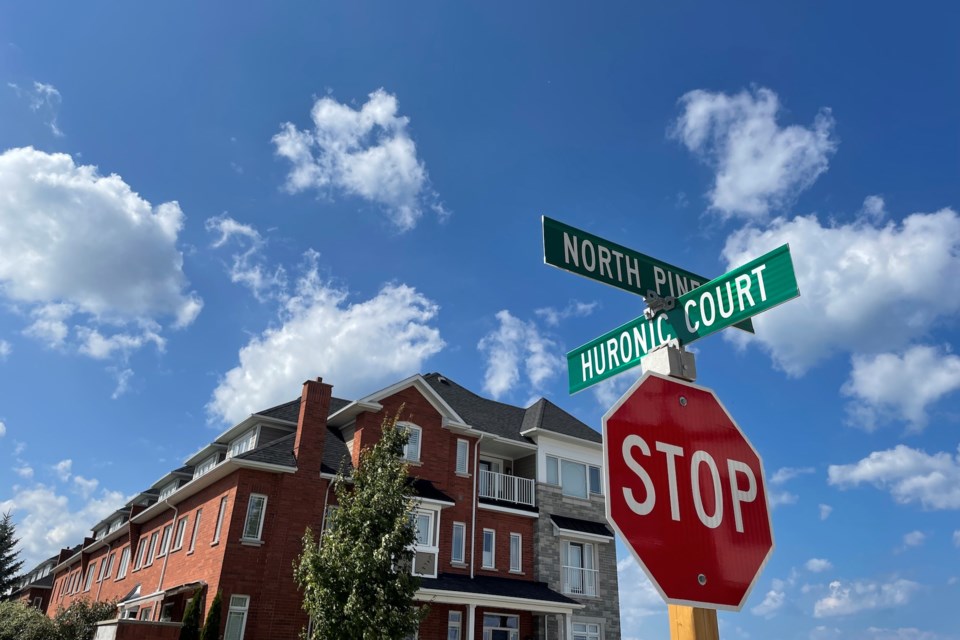What’s in a name?
A lot of history, apparently. At least when it comes to naming streets in Collingwood.
Trott Boulevard, for example, is named after the Trott family, owners of Trott's Furniture, which occupied a downtown block for more than 100 years (1867-1980s). Many ships built at Collingwood Shipyards were furnished with pieces built at Trott's.
The function of street naming and numbering is to enable people and emergency services to locate properties readily. In Collingwood, the naming of new streets or changing of existing ones requires approval from council through the passage of a by-law.
The town currently has a list of names that have been approved by council, so when a developer is looking to name a new street, or set of streets, they are sent the approved list and can select which names they prefer.
“Right now we have a fairly large list of names that have been approved over the years,” said Lynn Gowan, building department administrative assistant with the Town of Collingwood.
According to Gowan, the town has a policy that once every council term, she can present a report with a list of name suggestions for approval by council.
Anyone can propose a name, but Gowan asks that they provide reasoning as to why they think that name is valid or means something to Collingwood.
“We’re looking for some history there,” said Gowan. “Most of the names are rooted in history, whether it be an individual who was valuable to the community or a long line of families who are part of our heritage.”
During the 60s, the names of notable citizens were adopted for new streets, among them Gibbard, Campbell, and Telfer to name a few.
William Gibbard was Collingwood’s first land surveyor, and Telfer comes from Hall Telfer, who managed Telfer Bros. Limited, a biscuit manufacturer and wholesale grocer on Hurontario Street in the 1870s.
And then there’s Hurontario Street.
Hurontario Street was created in 1818 by combining the 8th Concession leading south from the harbour on Georgian Bay — which later became the site of Collingwood — and the southern part of the Toronto-Sydenham Road, which ran between Sydenham and the former Toronto Township.
The street's name is a blend of its two terminating Great Lakes; Huron and Ontario.
The story of the “tree streets" is less clear.
“The tree streets obviously go way back,” says Gowan, “But I actually don’t know the history there, or why they chose all streets for that section of town.”
Many of today’s streets in the grid of Fifth to Tenth Streets, as well as between Raglan and High Street, actually appear on the earliest known map of the town, printed in 1871 by John Hogg, founder of the town’s first newspaper, The Enterprise.
As one rumour goes, the lumberman who built homes on the west side of Hurontario Street chose names that paid homage to the source of their bounty — hence why we have the “tree” streets crossing the numbered streets on the original map.
Three homes on Third Street – 175, 185, and 199 – became the Toner homes, because they belonged to William T. Toner, his son William Toner, and F.B. Gregory, who was a partner in Toner and Gregory Lumber and Coal.
Gowan’s personal favourite is a newer, smaller road that was named a few years ago in the Shipyards development at the end of Pine Street: Huronic Court.
The name “Huronic” was actually not on the approved list of names at the time, but when the developer argued it was historically appropriate.
The Huronic was a steamship and part of a fleet of passenger vessels back in the early 1900s that were built for service on the Great Lakes, namely in the Collingwood area.
“That was neat,” said Gowan, “to choose the name because of a boat that was launched at the Shipyards.”
The steamship retired in 1949, but the name lived on.
It is for this reason that Gowan appreciates Collingwood’s street naming policy and their dedication to honouring the town’s history.
“I think it is a very unique way to keep the heritage here,” said Gowan. “It certainly brings more character to the town.”
